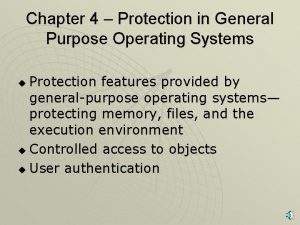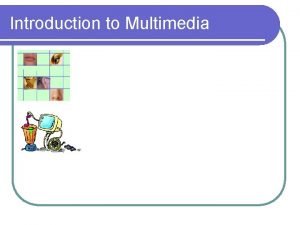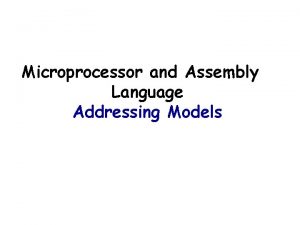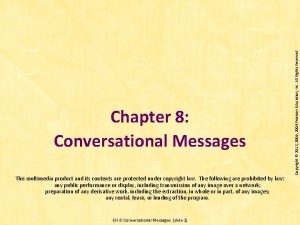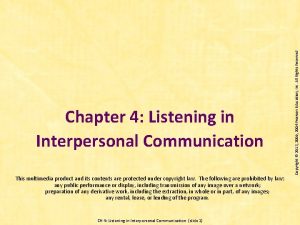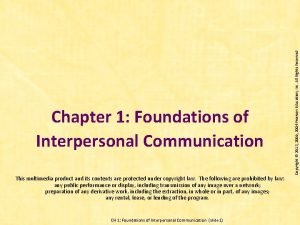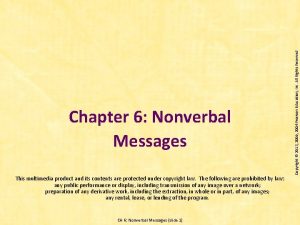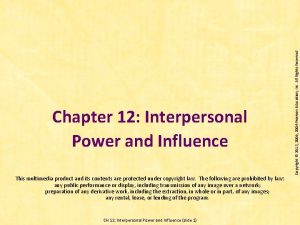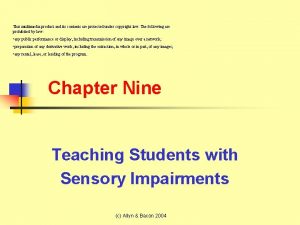This multimedia product and its contents are protected






















- Slides: 22

This multimedia product and its contents are protected under copyright law. The following are prohibited by law: any public performance or display, including transmission of any image over a network; preparation of any derivative work, including the extraction, in whole or in part, of any images; any rental, lease, or lending of the program. CH 5: Verbal Messages (slide 1) Copyright © 2013, 2009, 2006 Pearson Education, Inc. All Rights Reserved Chapter 5: Verbal Messages

§ Verbal refers to oral and written words § Verbal messages without words (laughter, vocalized pauses such as “um” or “erm”) are nonverbal CH 5: Verbal Messages (slide 2) Copyright © 2013, 2009, 2006 Pearson Education, Inc. All Rights Reserved Verbal Messages

Metacommunication § “Meta” – about § Metacommunication, metalanguage, metamessage § “Don’t talk to me that way. ” § “We need to talk about our fight. ” CH 5: Verbal Messages (slide 3) Copyright © 2013, 2009, 2006 Pearson Education, Inc. All Rights Reserved Verbal Messages (cont. )

1. Messages are packages of verbal and nonverbal signals 2. The meaning of a message is in the people, not the message itself; meanings are in people, not words CH 5: Verbal Messages (slide 4) Copyright © 2013, 2009, 2006 Pearson Education, Inc. All Rights Reserved Principles of Verbal Messages

3. Meanings are connotative and denotative § Denotative – objective § Connotative – subjective, emotional § Snarl words, purr words – highly emotionally charged negative or positive 4. Messages vary in abstractness CH 5: Verbal Messages (slide 5) Copyright © 2013, 2009, 2006 Pearson Education, Inc. All Rights Reserved Principles of Verbal Messages

5. Messages vary in politeness § Maintain positive face – seen positively or respected § Maintain negative face – stay autonomous § Indirect language is more polite § Cultural differences § In-group and out-group messages § Politeness online CH 5: Verbal Messages (slide 6) Copyright © 2013, 2009, 2006 Pearson Education, Inc. All Rights Reserved Principles of Verbal Messages (cont. )

6. Meanings can deceive § Types of lies: § Pro-social deception to achieve good § Self-enhancing deception to make yourself look good § Selfish deception to protect yourself § Anti-social deception to harm others § Ways people lie § Behaviors of liars CH 5: Verbal Messages (slide 7) Copyright © 2013, 2009, 2006 Pearson Education, Inc. All Rights Reserved Principles of Verbal Messages (cont. )

7. Messages can criticize and praise Praising § § Use I-messages Use positive facial affect (express your feelings) Name the behavior you’re praising Consider culture CH 5: Verbal Messages (slide 8) Copyright © 2013, 2009, 2006 Pearson Education, Inc. All Rights Reserved Principles of Verbal Messages (cont. )

7. Messages can criticize and praise (cont. ) Criticizing § § Own your thoughts and feelings with I-messages Be clear Avoid ordering or directing Consider the context or situation CH 5: Verbal Messages (slide 9) Copyright © 2013, 2009, 2006 Pearson Education, Inc. All Rights Reserved Principles of Verbal Messages (cont. )

8. Messages vary in assertiveness § “I win, you win” philosophy even in confrontation § Assertiveness varies culturally § Steps to assertive communication § § Describe the problem State how it affects you Propose workable solutions Confirm understanding CH 5: Verbal Messages (slide 10) Copyright © 2013, 2009, 2006 Pearson Education, Inc. All Rights Reserved Principles of Verbal Messages (cont. )

9. Messages can confirm and disconfirm § Disconfirmation –ignores the other person’s presence and communication; leads to lowered self-esteem § Rejection – disagree or reject the person’s ideas or behaviors but still recognize the person § Confirmation – acknowledges and accepts the other person; leads to increased self-esteem CH 5: Verbal Messages (slide 11) Copyright © 2013, 2009, 2006 Pearson Education, Inc. All Rights Reserved Principles of Verbal Messages (cont. )

CH 5: Verbal Messages (slide 12) Copyright © 2013, 2009, 2006 Pearson Education, Inc. All Rights Reserved

Offensive communication is disconfirming § § Language reflects and creates attitudes Intentional or unintentional Individual -isms Institutional -isms CH 5: Verbal Messages (slide 13) Copyright © 2013, 2009, 2006 Pearson Education, Inc. All Rights Reserved Principles of Verbal Messages (cont. )

Offensive language is disconfirming (cont. ) § Ableism – against people with disabilities § Racism – assumption of inferiority § Heterosexism – includes assuming that everyone is heterosexual CH 5: Verbal Messages (slide 14) Copyright © 2013, 2009, 2006 Pearson Education, Inc. All Rights Reserved Principles of Verbal Messages (cont. )

Offensive language is disconfirming (cont. ) § Ageism –toward elderly but includes other ages § Sexism – gender-biased language includes such as “generic he” § Biased listening CH 5: Verbal Messages (slide 15) Copyright © 2013, 2009, 2006 Pearson Education, Inc. All Rights Reserved Principles of Verbal Messages (cont. )

10. Messages vary in cultural sensitivity Cultural identifiers – language to talk to and about people of different groups § § Race and nationality Affectional (sexual) orientation Age Sex and gender CH 5: Verbal Messages (slide 16) Copyright © 2013, 2009, 2006 Pearson Education, Inc. All Rights Reserved Principles of Verbal Messages (cont. )

1. Extensionalize: avoid intensional orientation § Intensional orientation – view labels rather than things or people as they exist § Extensional orientation – view people or things as they are rather than how they are talked about their labels CH 5: Verbal Messages (slide 17) Copyright © 2013, 2009, 2006 Pearson Education, Inc. All Rights Reserved Guidelines for Using Verbal Messages Effectively

2. See the individual: avoid allness § Allness orientation – judge whole based on experience with part § Nonallness orientation – there is always more to know and say CH 5: Verbal Messages (slide 18) Copyright © 2013, 2009, 2006 Pearson Education, Inc. All Rights Reserved Guidelines (cont. )

3. Distinguish between facts and inferences: avoid fact-inference confusion § Factual statements – description based on things you observed § Inferential statements – conclusions based on what you observed § Fact-inference confusion CH 5: Verbal Messages (slide 19) Copyright © 2013, 2009, 2006 Pearson Education, Inc. All Rights Reserved Guidelines (cont. )

4. Discriminate among: avoid discrimination § Indiscrimination –stereotyping; focus on group instead of each unique member within group § Discrimination – recognize that not member in the group is alike CH 5: Verbal Messages (slide 20) Copyright © 2013, 2009, 2006 Pearson Education, Inc. All Rights Reserved Guidelines (cont. )

5. Talk about the middle: avoid polarization § Polarization – fallacy of either/or § Thinking in extremes makes us forget other possibilities CH 5: Verbal Messages (slide 21) Copyright © 2013, 2009, 2006 Pearson Education, Inc. All Rights Reserved Guidelines (cont. )

6. Update messages: avoid static evaluation § Static evaluation – keep attitudes and beliefs about someone despite inevitable changes CH 5: Verbal Messages (slide 22) Copyright © 2013, 2009, 2006 Pearson Education, Inc. All Rights Reserved Guidelines (cont. )
 Mikael ferm
Mikael ferm What is nonlinear multimedia
What is nonlinear multimedia Multimedia becomes interactive multimedia when
Multimedia becomes interactive multimedia when Multimedia becomes interactive multimedia when
Multimedia becomes interactive multimedia when Esa multimedia.esa.int./multimedia/virtual-tour-iss
Esa multimedia.esa.int./multimedia/virtual-tour-iss Difference between real protected and virtual mode of 80386
Difference between real protected and virtual mode of 80386 The kidneys are protected by the ribs and a cushion of fat
The kidneys are protected by the ribs and a cushion of fat Protected objects and methods of protection
Protected objects and methods of protection The emigree poem structure
The emigree poem structure Its halloween its halloween the moon is full and bright
Its halloween its halloween the moon is full and bright Example of multimedia products
Example of multimedia products Multimedia product
Multimedia product R087 interactive multimedia products examples
R087 interactive multimedia products examples Examples of multimedia products
Examples of multimedia products Product life cycle kotler
Product life cycle kotler Central idea of the production
Central idea of the production Product line and product mix
Product line and product mix Industry/target market feasibility analysis example
Industry/target market feasibility analysis example Gnp at gdp
Gnp at gdp Federally protected classes
Federally protected classes Protected in uml
Protected in uml Gta timesheet walmart
Gta timesheet walmart Protected mode memory addressing
Protected mode memory addressing







